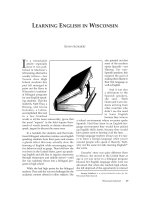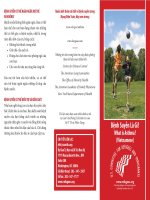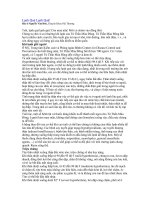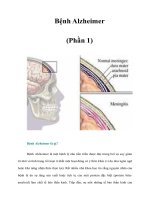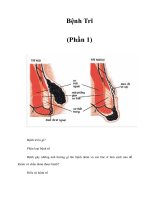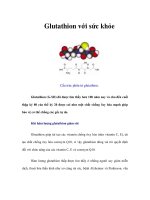Tài liệu Research Writing in Dentistry doc
Bạn đang xem bản rút gọn của tài liệu. Xem và tải ngay bản đầy đủ của tài liệu tại đây (1.99 MB, 199 trang )
fm BLBS051-Fraunhofer November 18, 2009 21:19 Char Count=
ii
fm BLBS051-Fraunhofer November 18, 2009 21:19 Char Count=
Research Writing
in Dentistry
i
fm BLBS051-Fraunhofer November 18, 2009 21:19 Char Count=
ii
fm BLBS051-Fraunhofer November 18, 2009 21:19 Char Count=
Research Writing
in Dentistry
J. Anthony von Fraunhofer
MSc, PhD, C.Eng, C.Chem, C.Sci, FADM, FASM,
FICorr, FRSC
Professor Emeritus
University of Maryland, Baltimore
A John Wiley & Sons, Ltd., Publication
iii
fm BLBS051-Fraunhofer November 18, 2009 21:19 Char Count=
Edition first published 2010
C
2010 Blackwell Publishing
Blackwell Publishing was acquired by John Wiley & Sons in February 2007.
Blackwell’s publishing program has been merged with Wiley’s global Scientific,
Technical, and Medical business to form Wiley-Blackwell.
Editorial Office
2121 State Avenue, Ames, Iowa 50014-8300, USA
For details of our global editorial offices, for customer services, and for
information about how to apply for permission to reuse the copyright material in
this book,
please
see our website at www.wiley.com/wiley-blackwell.
Authorization to photocopy items for internal or personal use, or the internal or
personal use of specific clients, is granted by Blackwell Publishing, provided that
the base fee is paid directly to the Copyright Clearance Center, 222 Rosewood
Drive, Danvers, MA 01923. For those organizations that have been granted a
photocopy license by CCC, a separate system of payments has been arranged.
The fee codes for users of the Transactional Reporting Service are ISBN-13:
978-0-8138-0762-1/2010.
Designations used by companies to distinguish their products are often claimed
as trademarks. All brand names and product names used in this book are trade
names, service marks, trademarks or registered trademarks of their respective
owners. The publisher is not associated with any product or vendor mentioned in
this book. This publication is designed to provide accurate and authoritative
information in regard to the subject matter covered. It is sold on the
understanding that the publisher is not engaged in rendering professional
services. If professional advice or other expert assistance is required, the services
of a competent professional should be sought.
Library of Congress Cataloging-in-Publication Data
Von Fraunhofer, J. A. (Joseph Anthony).
Research writing in dentistry / J. Anthony von Fraunhofer. – 1st ed.
p. ; cm.
Includes bibliographical references and index.
ISBN 978-0-8138-0762-1 (pbk.)
1. Dentistry–Research–Methodology. 2. Technical writing I. Title.
[DNLM: 1. Dental Research–methods. 2. Writing. 3. Data Interpretation,
Statistical. 4. Research Design. WU 20.5 V945r 2010]
RK80.V66 2010
617.60072–dc22
2009041426
A catalog record for this book is available from the U.S. Library of Congress.
Set in 10/12pt Palatino by Aptara
R
Inc., New Delhi, India
Printed in Singapore
1 2010
iv
fm BLBS051-Fraunhofer November 18, 2009 21:19 Char Count=
This book is dedicated to past, present and future dental researchers. Dentistry as
we know it would be impossible without you.
v
fm BLBS051-Fraunhofer November 18, 2009 21:19 Char Count=
vi
fm BLBS051-Fraunhofer November 18, 2009 21:19 Char Count=
Contents
Preface ix
PART I ORGANIZING, WRITING, AND PERFORMING
DENTAL RESEARCH
1 Introduction 3
2 What Is Research? 5
3 Research Planning 9
4 Performing Research 13
5 How to Design a Research Study 18
6 Non-Bench Research 28
7 Sources of Error and Avoiding the “Whoops” Factor 36
8 Reports, Theses, Dissertations, and Scientific Papers 40
9 Introduction and Literature Review 45
10 Methods and Materials (Experimental) 55
11 Results 57
12 The Discussion 62
13 Conclusions 68
vii
fm BLBS051-Fraunhofer November 18, 2009 21:19 Char Count=
viii Contents
14 The Abstract 70
15 Writing Style and Technique 73
16 Getting Published 76
PART II STATISTICS AND STATISTICAL ANALYSIS
17 Basic Statistics 83
18 Data and Data Distributions 87
19 Averages (Measures of Central Tendency) 91
20 Measures of Dispersion 96
21 Probability and the Normal Curve 100
22 Presentation of Data 108
23 Comparing Sample Means 115
24 Student’s
t
-Test 122
25 Analysis of Variance 129
26 Power Analysis 139
27 Multiple Comparisons 145
28 Chi-Square Test 153
29 Correlation and Regression 159
30 Weibull Analysis 166
31 Ranking Tests 175
Appendix—Further Reading 183
Index 185
fm BLBS051-Fraunhofer November 18, 2009 21:19 Char Count=
Preface
The purpose of this book is to provide the inexperienced scientist, notably
junior faculty, residents, and predoctoral clinical students, with practical
guidance on how to go about finding a research project and how to design
appropriate studies and then write up the results. In order to provide a
useful “how to” book, the approach is to give concrete advice and infor-
mation as well as show how a program of research work can be developed,
analyzed, and presented.
It order to complete a research project and write it up as a thesis or dis-
sertation, a publication in a scientific paper or a presentation at a scientific
meeting, the generated data must be subjected to statistical analysis. Ac-
cordingly, Part II of this book covers statistics and statistical analysis. The
treatment is based in large part upon the Microsoft Excel spreadsheet and
the ProStat statistical program using practical examples.
I thank my daughter, Dr. Nicola von Fraunhofer, and my good friends
and respected colleagues, Dr. Sharon Siegel, Dr. Leslie Gartner, and Dr.
Sean Wetterer, for reading and commenting upon various chapters. Their
advice, comments, and suggestions have been invaluable. On a personal
note, I like to express my appreciation to my wife Susan for her patience,
support, and generous TLC during the writing of this book.
J. Anthony von Fraunhofer
ix
fm BLBS051-Fraunhofer November 18, 2009 21:19 Char Count=
x
c01 BLBS051-Fraunhofer November 13, 2009 20:2 Char Count=
Part I
Organizing, Writing, and
Performing Dental Research
1
c01 BLBS051-Fraunhofer November 13, 2009 20:2 Char Count=
2
c01 BLBS051-Fraunhofer November 13, 2009 20:2 Char Count=
1
Introduction
Academics commonly are required to do research and publish to achieve
promotion and tenure. Undertaking a research project is also an increas-
ingly common course requirement for undergraduate and professional
school students. Admission into good colleges and universities often ne-
cessitates that prospective students demonstrate intellectual achievement
above and beyond good grades, and this frequently requires some form
of research endeavor or at least participation in a research project. Simi-
lar considerations are equally applicable for new graduates or senior year
predoctoral students who are attempting to gain admittance into gradu-
ate programs. Without some form of research credentialing, graduate pro-
gram directors may pass over viable candidates in favor of a person who
has gone that extra yard during predoctoral training. In other words, it is
very beneficial to one’s career prospects to be able to demonstrate intellec-
tual curiosity through some sort of research involvement.
Most people, however, are immediately intimidated when confronted
with the prospect of doing research and there tend to be feelings of “I am
too old, tired, inexperienced, undereducated or too busy to do research.”
Such attitudes, though common, are a disservice to the prospective
researcher in particular and to the advancement of knowledge in general.
Further, such attitudes deprive the putative researcher of the pleasure
and satisfaction of discovery and the chance to do something that no one
else has ever done before. We all know the pleasurable feeling (and, let us
face it, the slight feeling of superiority) that one gets from the simple task
of sharing knowledge or expertise with someone else. “Hey, I’ve found
a good short cut to the supermarket/office/mall etc.” or “Have you tried
this?” are very common and simple demonstrations of time well spent
in acquiring new knowledge . and that really is what research is all
about.
The approach adopted in the following chapters has been to identify an
issue that needs to be resolved and show how this can lead to a series of
3
c01 BLBS051-Fraunhofer November 13, 2009 20:2 Char Count=
4 Organizing, Writing, and Performing Dental Research
research projects. Then, the suggested research projects will be outlined to
indicate how the projects should be pursued.
This book provides a practical guide to performing a research project
and, equally important, how to share that knowledge with other people be
it in the form of a thesis/dissertation, a scientific paper, a poster or an oral
presentation such as a lecture. To all intents and purposes, research data
that are not shared with others do not exist but, as virtually every gradu-
ate student will tell you, communicating that information is difficult. Most
of us know one or more people who are “ABD” (all but dissertation), peo-
ple who cannot complete their master’s or PhD degrees because they have
yet to write up their research findings as a thesis or dissertation. Conse-
quently, the second objective of this book is to help undergraduate and
postgraduate students and other knowledge generators to write up their
research and gain the recognition that their hard work and efforts truly
deserve.
c02 BLBS051-Fraunhofer November 13, 2009 20:11 Char Count=
2
What Is Research?
Dictionaries typically define research as:
a. A diligent search or inquiry, or
b. A scientific investigation and study to discover facts
A moment’s reflection tells us that everyone does some form of research
virtually every day of their lives. The actual task might be as simple as lo-
cating the nearest veterinary practice when one moves into a new neigh-
borhood, finding a new physician or dentist, locating a supermarket or
simply checking street maps to find the fastest and most convenient route
to work each day. Research may also involve far more complex undertak-
ings such as investigating the role of zinc in preventing prostate cancer or
the causes of metal allergy in patients with metallic dental restorations.
In other words, any intellectual undertaking that involves asking, and an-
swering, questions that require the questioner to acquire new knowledge
or organizing existing knowledge to answer questions is, by definition,
research.
FINDING A RESEARCH PROJECT
Research in the academic setting is the generation and/or acquisition of
new knowledge but in order to assure success in a research project, there
has to be an underlying interest in the subject on the part of the researcher.
The researcher must find a field or area of interest and then decide upon
a specific question or problem that has to be answered or explained. Even
if one’s research activity involves simply helping a senior researcher in
his or her work or doing rote experiments under the direction of someone
else within the scope of a larger study, you can still make a contribution
to advancing knowledge by asking why something happens or whether
5
c02 BLBS051-Fraunhofer November 13, 2009 20:11 Char Count=
6 Organizing, Writing, and Performing Dental Research
there might be another way to perform the same task. Ask; if the answer
is unclear or unsatisfactory, look into the matter. That is how ideas are
generated.
Asking oneself why something happens the way it does or if a par-
ticular effect can be avoided by a change in material selection or pro-
cedure likewise are fertile fields for projects. Looking at the literature
and reading articles published in different journals also raise research
questions—clearly, if you read the article, then you obviously have some
interest in the subject, so why not take the next step and look into it more
deeply? Since virtually no research paper is definitive and, therefore, can-
not satisfy all aspects of a problem, a careful review of the literature will
soon raise a number of questions worth investigating.
There are several interpretations of the literature on a particular topic. It
is possible, for example, that what is not said is more important than what
is said. It is very rare for any published paper or even a textbook to cover
every aspect of any given subject and, for example, let us not forget that
Einstein’s relativity theory did not address what happens when a particle
exceeds the speed of light. Thus, what has not been covered in a published
paper or research program offers fertile ground for further research by
others.
Similarly, a technique may have been used in a particular study not
because it was the best approach but because it was the only one avail-
able to the researchers. Many important research projects and experimen-
tal findings have evolved from asking such simple questions as “why did
someone use this particular approach or technique rather than something
else?”
Simply put, all research can be summed up as shown in Table 2.1.
At the start of the project, the researcher must formulate a theory or
supposition and this is known as a hypothesis. The hypothesis is the basis
or framework for the research since the program of work is directed at
establishing the validity of the hypothesis.
Most clinicians actually formulate a hypothesis every time they see and
treat a patient. For example, a patient may present with complete denture
and complain of irritated cracks and fissures at the corner of the mouth,
and possibly excess saliva. The immediate diagnosis is that the patient is
Table 2.1 Basics of research.
What are you going to do?
How are you going to do it?
What do you expect to find?
What are you going to do with the information?
c02 BLBS051-Fraunhofer November 13, 2009 20:11 Char Count=
What Is Research? 7
suffering from angular cheilitis caused by loss of vertical dimension. This
would be the basic hypothesis or H
0
. The alternative hypothesis, H
1
,isthat
the cheilitis is the result of a vitamin B deficiency or a yeast infection (e.g.,
a candida-induced stomatitis). Thus, when the clinician examines the pa-
tient and finds that the occlusion is balanced and that the patient has not
lost vertical dimension, he or she will likely decide that H
0
has not been
validated or proved. The clinician then will reject H
0
and accept the alter-
native hypothesis, H
1
, and treat the patient accordingly, that is, prescribe
vitamin supplementation and/or attempt to eliminate the yeast infection.
In other words, when a clinician evaluates a patient and decides upon a
course of treatment, the thought process parallels that of a researcher de-
ciding upon a project, developing basic and alternative hypotheses and
then working to validate or reject the hypotheses.
Although deciding upon a suitable research project and formulating a
hypothesis may appear to be daunting, in fact, neither task is difficult as
long as you maintain an open, receptive mind. The latter permits you, the
researcher, an opportunity to ask questions that have not already been an-
swered in detail by others. However, you the researcher must always ad-
here to the basic principle that if you are not interested in the subject, then
doing research can become very tedious and might even be abandoned if
the experience becomes too unpleasant.
Four things must be borne in mind with regard to research:
1. No one, repeat no one, walks into the laboratory first thing in the morn-
ing, shakes a test tube, shouts “Eureka” and writes off to the Nobel
Prize Committee! Most of the time, one looks at data readings, charts,
and graphs and then mutters darkly about the need to repeat measure-
ments or even go back to the drawing board because things did not
work out as expected.
2. It cannot be stressed enough that the first and most essential task before
starting any research project is to review the literature. The literature
will tell you what has been done, how it was done, and usually what
it all means. Although reviewing the literature was mentioned earlier,
it is worth repeating that every hour spent online or in the library will
save at least 10 or more hours in the laboratory.
3. Focus on the view, not the window. Novel techniques and sophisti-
cated laboratory instrumentation are often wonderful advances, but
focusing on the methodology rather than on what you are actually
trying to investigate more often than not leads to frustration and dis-
appointment.
4. If it does not make sense, it is probably wrong. Weird and totally
unexpected things do happen and are real phenomena but most of
the time, things that are wildly different from the norm are usually
c02 BLBS051-Fraunhofer November 13, 2009 20:11 Char Count=
8 Organizing, Writing, and Performing Dental Research
artifacts. This is why all experiments have to be repeated several times
and, indeed, all the experimental parameters including the test materi-
als have to be checked just to make sure that the untoward observation
was not simply another example of the law of universal cussedness.
(If things can go wrong, they will.)
c03 BLBS051-Fraunhofer November 13, 2009 20:22 Char Count=
3
Research Planning
Einstein once said, “If we knew what we doing, we would not call it
research.” However, we can level the playing field. Seneca the Younger
stated “Luck is what happens when preparation meets opportunity” and
Louis Pasteur paraphrased this as “Fortune favors the prepared mind.”
All great philosophers, generals, artists, writers, and creative people make
careful preparations before embarking upon any endeavor. If thorough
preparation is good enough for the greatest of minds, then it is manda-
tory for the rest of us.
Ideally, before starting upon the research project, the researcher must
formulate a theory or supposition and this is known as a hypothesis.The
hypothesis is the basis or framework for the research since the research
program is directed at establishing the validity of the hypothesis. This
process is outlined in Figure 3.1.
Unfortunately, developing the research hypothesis in a clear and
methodical manner, as shown in Figure 3.1, is not always possible and
establishing a basic hypothesis is often very difficult. If the researcher
is working toward a higher degree, then it is sensible to seek the advice
of a supervisor or mentor for guidance in developing a research project.
When the researcher does not have access to a suitable supervisor, then
the research hypothesis must be formulated through careful and critical
appraisal of the literature.
In many cases it may not be possible to formulate a research hypothesis
before starting on the research program. For example, a dental material or
drug can be studied without formulating a working hypothesis at the out-
set, a typical case being a study directed at evaluating or characterizing
the properties of the new product. Once the initial work has been com-
pleted, the researcher can then undertake research aimed at explaining
the behavior or properties of the material in question, that is, to formu-
late a working hypothesis. Similar considerations apply in a wide variety
of projects; that is, the researcher performs a few initial or exploratory
9
c03 BLBS051-Fraunhofer November 13, 2009 20:22 Char Count=
10 Organizing, Writing, and Performing Dental Research
Field of interest
Specific topic
Review the literature
Question to be answered
Establish a hypothesis
Figure 3.1 Developing the research hypothesis.
experiments that provide a “feel” for the subject. Then, based on the find-
ings of the initial work, it is possible to develop the working hypothesis
and get started on the full program of work.
Another approach to developing a hypothesis and research program is
to apply a new technique to an old problem, that is, a re-research project.
While useful data may often be produced by this type of study, it is pos-
sible that the researcher could be criticized for examining a nonproblem,
that is, the focus is on the window not the view. Common sense should
be the guide here. If the research produces facts and figures in place of
previously vague generalizations, then the work is valuable. But if the
project is directed at doing yet another study of an old and well-known
phenomenon using a new technique but which has little likelihood of gen-
erating new knowledge, then the research project might be ill-advised.
PLANNING THE RESEARCH PROJECT
There is no set approach to any problem. Individuals will tackle tasks in
completely different ways, and this includes such common activities as
driving or painting a house as well as more complex undertakings such as
research planning and experimentation. Consequently, it is only possible
to advise and recommend rather than to lay down rigid guidelines on
how to do research. The ideal approach is indicated in Figure 3.2 and can
be summarized as follows:
a. Project is established with a (working) research hypothesis
b. The literature is critically reviewed—if the subject has already been
studied in depth, then the project must be changed or modified
c03 BLBS051-Fraunhofer November 13, 2009 20:22 Char Count=
Research Planning 11
Literature
review
Available facilities
and expertise
Experimental
work
Results
Discussion
Conclusions
Change or modify research plan if
the literature indicates that the
subject has been studied in depth
Change or modify research plan
when adequate research facilities,
expertise, or mentorship unavailable
Proposed
research
Results should be discussed in
relation to the literature
Figure 3.2 The ideal research project.
Note
: If the findings of the study differ markedly
from those of previous studies, secondary experiments should be performed to determine
the source of these differences and to ensure that the findings of the study are valid.
c. Laboratory facilities, availability of materials, and, notably, advice and
mentorship (guidance) should be evaluated and secured—if suitable
facilities, mentoring, or equipment is not available, then the project
should be changed or modified
d. The experimental work is performed
e. Results are evaluated and subjected to statistical analysis
f. The results are discussed and the findings related to the previously re-
ported data in the literature
g. Conclusions are drawn
c03 BLBS051-Fraunhofer November 13, 2009 20:22 Char Count=
12 Organizing, Writing, and Performing Dental Research
A new class of material or drug, an improved testing methodology, a
change in test parameters, and a host of other factors can and usually will
make your own work unique and special.
There are, however, two highly important factors in research. First,
there is intuition. The experienced and, as often as not, the inexperienced
researcher will feel that something does not appear to be “right” or that
the findings are not in accord with the anticipated results. When this hap-
pens, the good researcher will return to his or her study and look for any
sources of error or unexpected variability before deciding that the ob-
served findings are real rather than artifact. A second factor that enters
into research is the basic principle that it is virtually impossible to prove a
negative. Proving that a treatment plan, clinical procedure, or a new ma-
terial or drug is beneficial to the patient is generally straightforward. Like-
wise, harmful or adverse effects upon the patient are usually unequivocal.
However, to prove that something is not harmful is extremely difficult, if
not impossible.
Researchers must develop a critical sense. It is important to remember
that even though a paper might have been published in a good journal by
a reputable author, it does not automatically mean that the findings are
correct or that they have been interpreted correctly. If the discussion and
conclusions of a published paper are not in accord with the experimen-
tal results, or when several authors hold differing opinions on the same
phenomenon, there is scope for re-examination.
c04 BLBS051-Fraunhofer November 13, 2009 20:28 Char Count=
4
Performing Research
In the same way that people rarely perform the same task in identical
ways, every researcher has an individual approach to tackling a research
project. Nevertheless, there are three principal approaches to research
once the basic hypothesis has been established:
1. Trial-and-error approach: Random experiments are performed until a
promising line of research is found. The researcher then determines
which factor produced the required result or the greatest effect and
proceeds to work in ever-widening circles about this central point.
2. Progressive approach: There is a methodical progression from some point
at which every parameter is fixed to another point with each param-
eter being varied in turn (while every other parameter is kept con-
stant) until all variables have been evaluated. This process is repeated
until the desired end point has been reached although careful use of
statistics can simplify the research methodology. Interesting sidelines
or offshoots of the main program are followed up only after the major
pattern has been established and fully investigated.
3. Direct approach: The project follows a rapid and direct progression from
a starting point, which is well established and quantified, to the
desired end product, with minor excursions along any interesting side-
lines.
None of these approaches is completely satisfactory and two or three of
them may be combined within a single project. Although it is important
that the approach is always directed toward accepting or rejecting the
null hypothesis (H
0
), other pressures may affect the researcher’s strategy.
Many younger researchers are pushed by their mentors, departmental
chairperson or management to publish their findings as soon as possible,
the so-called “publication fever.” While early and frequent publication
may satisfy such demands, it is easy to overlook significant findings in
13
